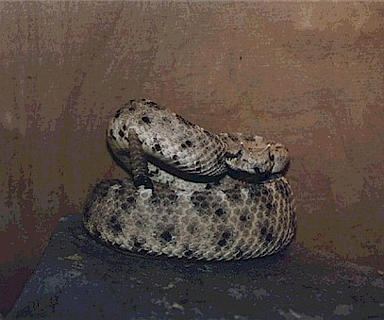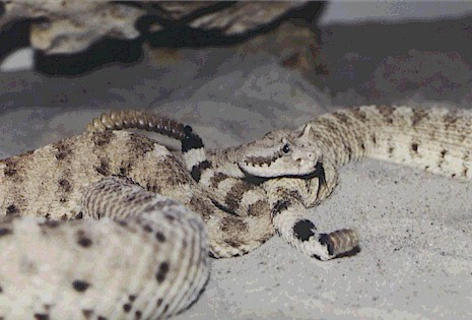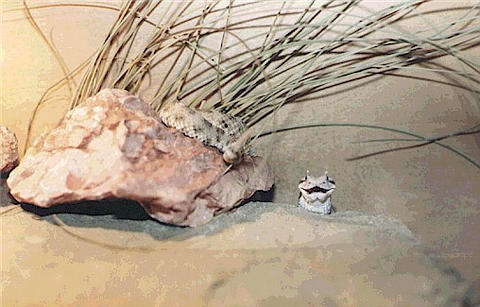The Sidewinder
from
John Bakker
Website:
http://sidewinder78.tripod.com/TheSidewinderRanch/index.html
on
December 29, 2001
View comments about this article!
The Sidewinder
Crotalus cerastes
My experience with keeping and breeding this species.
By John Bakker, The Netherlands
History
The sidewinder is a small rattlesnake from the southwest range of the United States and the northwest of Mexico. Hallowell was the first to describe the species in 1854 as Crotalus cerastes (58.7 cm). L. Klauber described the subspecies C.c.laterorepens (62.8 cm) in 1953.
The habitats of Crotalus cerastes are the sandy deserts with little or no vegetation (creosote bushes) and sometimes-rocky hills. The difference between the three subspecies (aside from geographical variations) is primarily their size, with C.c.laterorepens being the largest. Furthermore, the first segment of the rattle of C.cerastes cerastes is brown, and black in C.c.cercobombus and C.c.laterorepens.
All three sidewinders have the characteristic elevated scales (horns) above their eyes. It is thought that these "horns" protect the eyes when digging in the sand. The color of the three species varies from yellow, light brown to grey.
The belly of Crotalus cerastes cercobombus is normally of a creamy white color. All three sidewinders have 28-45 red-brown spots along the length of their back. Along the length of the back are from 141-146 scales.
Diet
The diet of Crotalus cerastes consists primarily of mice, kangaroo rats and lizards. Funk (1965) also mentioned birds (sparrow) and small snakes (Arizona, Chionactis, Crotalus cerastes and Sonora).
 Photo by John Bakker (c)2001
By nature Crotalus cerastes is primarily nocturnal and cars kill many snakes while they lay on the (still) warm asphalt. In spite of their small size, they are still a complete rattlesnake. The venom is potentially deadly and the only reason that bite accidents normally are not fatal is because of the small quantity of venom that is injected. The rattle is well developed and can be heard from a long distance away.
My animals
My animals are a male and a female Crotalus cerastes cercobombus. The male (captive bred in 1993 in Germany) I bought in February 1996. The animal was and still is about 40 cm long. It was placed in a terrarium measuring 100-50-50 cm. This terrarium was heated using a 60-Watt lightbulb, which was placed over a rocky cave. As a substrate I used sand and some rocks. Cactuswood and a small water container were placed in the terrarium. The DTH was 35° Celsius under the lightbulb and 22° Celsius at the other end of the terrarium. NTL was 20° Celsius.
The male is a moderate eater who eats about six mice between two hibernations. After I had the male for about six months, I bought a beautiful looking female at a snake convention. I could not have been happier, but the very next morning she died!
Several months later I bought 10 one-month-old juveniles. Each animal was placed in a transparent shoebox with sand as a substrate, a hiding box and a watercontainer. These shoeboxes were placed on a heating strip.
In the beginning all the animals refused to eat, but after several force-feeding they all took pinkies willingly. Prey was offered every 7-10 days and the juveniles did well. When the animals were about 4 months old they began to die one by one. After research there was no cause found. All the young ate well and then died one or two days later. (If there is anyone who has any idea why, please let me know).
After this disappointment I bought an adult female in October 1998. Because I knew the owner and had seen the animal many times at his house. I was sure I could place the two animals together. Well, that was a hit. I put the two together at 1800 hrs and ten minutes later they were in copula until 1120 hrs the next morning. This kind of mating was seen daily over a long period and when the animals were placed in hibernation there were 162 hours of mating on the record. The female had eaten the entire time, sometimes even during mating.
 Photo by John Bakker (c)2001
The animals were placed in hibernation in November 1998 at a constant temperature of 15° Celsius. In March the animals were placed back in the terrarium with the normal heating. The female started eating right away but the male only wanted to mate. Maybe this is the time to mention that according to Renae Thijssen, two males cannot be kept together. He has seen that some males, who were kept together for a long time, started to bite each other heavily for no apparent reason.
The actual breeding
In the following weeks, I observed numerous matings. The female always stayed in the warm area of the terrarium and ate everything she could catch. She became heavier, and on the 24th of June she laid 8 infertile eggs. After I cleaned the terrarium, I offered her two mice, which she took like there was no tomorrow. Much to my surprise, the two lovers were in copula the next morning.
In October there were another 130 hours of mating on the record. But what went wrong the last time? Was one of the animals infertile or was the female already pregnant and did the eggs die during hibernation? After discussing this with my friend Renae Thijssen, we decided to use the following technique. The animals were not placed in hibernation and a 15-Watt heating pad was placed in the rocky cave, which was heated 24/7.
 Photo by John Bakker (c)2001
The lightbulb was burning on the normal schedule. This gave the animals the chance to select their favourite spot. It was odd to see that the female stayed in the cool area of the terrarium almost all of the time. The animals just kept on mating and both stayed on their food. In the beginning of March, the female became extremely heavy. With a length of 52 cm, the girth of her body measured about 20-cm. From March on she stayed on the heating pad at night with the rear end of her body, but as soon as the light went on she went to the cooler area. Her eating habits were ferocious, -- 2-3 mice were taken and if I were not careful, she would steal the mouse from the male.
From the end of April on she stayed almost constantly on the heating pad. Only with the extreme temperatures in the first two weeks of May she would sometimes leave the hotspot.
On the 9th of May she refused food for the first time since 1998. She stayed near a mouse with her head resting on it as if she wanted to save it for later. After I removed the smelly mouse after two days she instantly moved to the warm end of the terrarium.
On the morning of May the 14th 2000 I noticed that the lightbulb was not working. Since it was 28° Celsius outside I decided to replace it later. When I opened the terrarium (after checking with a flashlight where the animals were) I could see the female dropping young at the cool end. This was about 2100 hrs. I decided not to disturb the female and to check on her every hour. About 2350 hrs the female was done giving birth. Surprisingly, the male was in the far end of the terrarium all this time, while normally they were together constantly. I then took the adults out of the terrarium. The normally docile female was very aggressive at this time. Then I took all the cage furniture out to find the newly born. The result was 12 live young and 5 infertile eggs. The juveniles were placed in shoeboxes with a small drinking container and a shelter. The boxes were placed on a heating pad. As a substrate I used ground corn cobs, which I use for the adults too for about a year now. Now I have to wait and see if I can get the juveniles to the adult stage.
I got a good tip from a friend, Renae Thijssen. He has bought many young sidewinders in the past and they have all survived. One of his techniques is to give all the juveniles a drop of water on a regular basis. This is done by placing a drop of water on the juveniles mouth with a pipette. I cannot say if this method works, but it is worth trying. Who knows?
My experience with young Bitis shows that young snakes of this species have to "learn to drink". In all rattlesnake literature it is said that C.cerastes get all the moisture they need from their prey, but perhaps not.
I would like to thank Rena Thijssen for his advice and cooperation, and my very good friend Fred Van Lit for editing the English version of this article.
Bibliography:
- Pete Strimple, Crotalus cerastes-Litteratura
- Serpentium 1993 Vol.13, Nr 6
- Carl H. Ernst, Venomous reptiles of North America 1992
- Chris Mattison, Rattler! A natural history of rattlesnakes
- Foto's by the author
Email: Navajo@hetnet.nl
|
The Sidewinder
|
Reply
|
|
by sniper on December 30, 2001
|
Mail this to a friend!
|
That is a great article. As someone that just moved to the southwest and keeps `winders, you have put together a very good over view of keeping these animals.
Thanks, I`ll use your info for my animals.
Bill.
|
| |
|
RE: The Sidewinder
|
Reply
|
|
by serpentinespirit on July 6, 2002
|
Mail this to a friend!
|
|
the sidewinder has always been my fave of all the domestic rattlers, i would love to get one, if you know anyone who wants to sell or trade for a dusky pygmy, let me know, cheers, james
|
| |
|
The Sidewinder
|
Reply
|
|
by Snakeskin on July 20, 2003
|
Mail this to a friend!
|
Very nice! (have read the dutch version already :) )
Good to hear you'l keep breeding them.
(just for readers' info, I've bought 2 Crotalus c c Neonates from John, and they are absolutely perfect snaks (if you get them feeding that is :) )
Bye,
Peter
|
| |
|
RE: The Sidewinder
|
Reply
|
|
by Toomas on September 6, 2003
|
Mail this to a friend!
|
Sidewinders are nice snakes!
I publish small herpmagazine RÄSTIK (Adder), where are articles in estonian but are abridged versions from all articles in english).
In next issue is article about Mojave Sidewinder (Crotalus c. cerastes). This subspecies is quite interesting but very tiny. Especially juveniles whom should force-feed quite long time. Very often to 1 year. After that they eat without help.
Other two subspecies - Colorado Sidewinder (Crotalus c. laterorepens) and Sonora Sidewinder are much bigger.
Toomas
http://www.hot.ee/loomademaailm/rastik
|
| |
|
The Sidewinder
|
Reply
|
|
by Waglerstempleviper on September 9, 2004
|
Mail this to a friend!
|
|
hey John that is a very good article you wrote and makes me want to work with Sidewinders even more. I am 14 years old and have the experience needed and know the responsibilities towards keeping these snakes. Do you think it is okay for me to keep Sidewinders as my first venomous. I have worked with these guys before, so I know what I am doing. I have also worked with other rattlesnakes out in the field.
|
| |
|
The Sidewinder
|
Reply
|
|
by CanadianSnakeMan on April 16, 2006
|
Mail this to a friend!
|
Thank you for your article. I have been seriously considering keeping sidewinders lately and this article has given me some much needed insight.
Luke
|
| |
|
The Sidewinder
|
Reply
|
|
by cryptidhunter on December 29, 2009
|
Mail this to a friend!
|
Great article, very informative and I enjoyed it very much.
Since the original article was written several years ago, how about writing an update discussing how everything went with the neonates and what you have going on with this species now?
Shannon
|
| |
|
The Sidewinder
|
Reply
|
|
by cryptidhunter on December 29, 2009
|
Mail this to a friend!
|
Great article, very informative and I enjoyed it very much.
Since the original article was written several years ago, how about writing an update discussing how everything went with the neonates and what you have going on with this species now?
|
| |
|
The Sidewinder
|
Reply
|
|
by westcoast74 on January 16, 2010
|
Mail this to a friend!
|
|
Great article. I am looking to purchase a pair or two of Crotalus cerastes Sonoran and mojave or other southern Cal subspecies. Captive born only. Cash paid. Will p/u within 150 miles.
|
| |
|
Email Subscription
You are not subscribed to discussions on this article.
Subscribe!
My Subscriptions
Subscriptions Help
Other Captive Care Articles
 Jameson's Mamba Captive Care
Jameson's Mamba Captive Care
 Captive Care and Breeding of the Monocle
Captive Care and Breeding of the Monocle
 Keeping Kraits
Keeping Kraits
 The Black Mamba
The Black Mamba
 Captive Care of the Russell's Viper
Captive Care of the Russell's Viper
|

